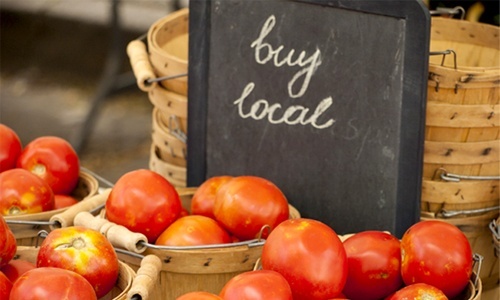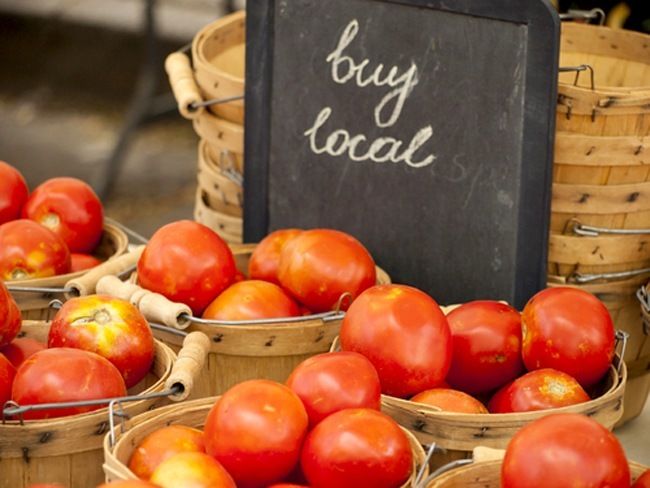

One of the easiest and most powerful ways we can make a difference is through our decisions as consumers. What we choose to buy not only says a lot about who we are and what kind of values we have, but also has many cumulative repercussions, from helping to shape corporate and public policy to affecting animal welfare, public health, social justice and the global environment.
An ad for BuyPartisan, an iPhone app that scans bar codes to reveals whether any given product is made by Republicans or Democrats, puts it succinctly: “We vote everyday with our wallets.”
And one of the best ways to vote with our wallets is through our grocery shopping. According to a 2014 Gallup poll on consumer spending, Americans are opening up those wallets more for groceries than for other household essentials. Fifty-nine percent of Americans reporting increased spending on food shopping, ahead of spending on gasoline (58 percent), utilities (45 percent), healthcare (42 percent) and rent or mortgage (32 percent).
According to Progressive Grocer Magazine, supermarkets made more than $638 billion in sales in 2014. Clearly, as long as money talks, grocery shopping remains an ideal opportunity to “cast your vote” in numerous ways. Here are seven ways to help transform your grocery list into a ballot for positive change.
1. Buy organic
It’s a good instinct to seek out organic products over non-organic ones. Unfortunately, the word “organic” is problematic. If a product has the “100 percent organic” label, it means that is passes the U.S. Department of Agriculture’s (USDA) definition: meat, eggs and dairy are antibiotic- and hormone-free; animals are raised in living conditions that permit them to engage in natural behaviors (like grazing on pasture); produce is made without fertilizers that are synthetic or have sewage components; and no genetically modified ingredients. But the USDA’s certification permits certain pesticides and herbicides, and also allows five percent of the ingredients to be non-organic, meaning that food producers can add some 200 non-organic substances to their products and still get the USDA’s organic stamp.
When it comes to imported foods labeled organic, the issue is even thornier. For these products, “an extended bureaucratic chain increases the opportunities for fraud and lax enforcement, especially when food is imported from places rife with corruption, such as Ukraine and Kazakhstan,” says Peter Laufer, a journalism professor at the University of Oregon and author of Organic: A Journalist’s Quest to Discover the Truth Behind Food Labeling.
For organic purists, the USDA label isn’t enough, and there is no other regulated third party certification. So getting something that is actually “100 percent organic” isn’t always possible. But though the term “organic” is conflicted, it is still most often a better choice to go organic over non-organic foods. Your best bet would be to support your local organic farmer at the nearest farmers’ market: Not only will you be helping your local economy, which benefits you in the long run, you will be choosing foods that didn’t require too much transportation to get to you (and therefore, less carbon emissions) and also supporting local farmers instead of Big Ag corporations and multinational food conglomerates.
As the organic markets mature, hopefully a better certification process will be developed. But a big hurdle remains cost effectiveness: In many cases, organic food is costlier to make, and thus pricier, than their traditional counterparts. Hopefully, the surging consumer demand will inspire more farmers to convert from conventional to organic farming, which could bring organic prices down.
A 2014 Gallup poll found that 45 percent of Americans actively seek out organic foods, 38 percent say they “don’t think either way” about organic and 15 percent actively avoid them. For many farmers, food producers and distributors, the organic-seekers represent a potential customer base that too big to ignore. Clearly, there is a huge demand for food that is free from man-made additives like from antibiotics and pesticides, and is produced in a way that is better for the environment. And with younger people more likely than older people to eat organic, that segment of the market will likely grow. (Last year was the first year that Gallup asked about eating organic foods in their annual Consumption Habits survey, so it will be interesting to follow this trend in subsequent surveys.)
2. Buy in bulk
When it comes to product packaging, convenience comes with a hefty environmental price. Much less plastic is used for a gallon jug of water versus 16 eight-ounce bottles. (And anyway, plastic water bottles of any size should be avoided at all costs; refill a steel water bottle with a Brita instead.)
“While it may seem easier to get individually wrapped snacks and beverages, that convenience is adding to the over 60 million tons of paper, plastic and glass packaging thrown away in the U.S. every year,” according to Green Home.
Look for products with minimal packaging, choosing paper over plastic as the lesser of two evils. Buy in bulk and then transfer the products into smaller, more convenient reusable containers at home.

 233k
233k  41k
41k  Subscribe
Subscribe 
